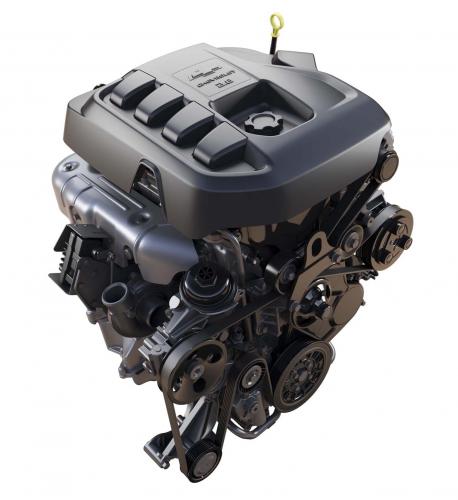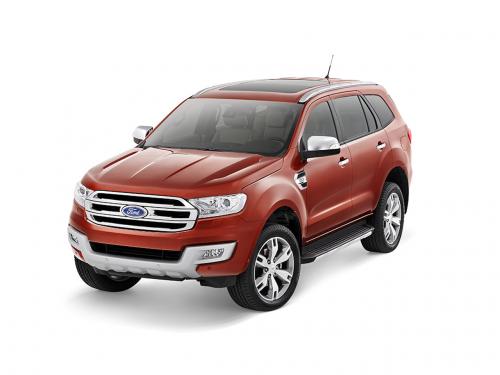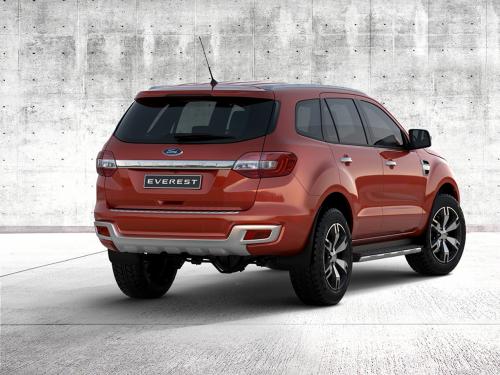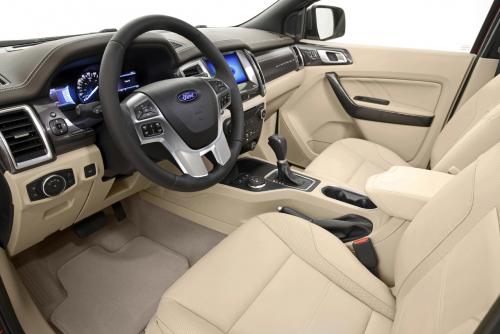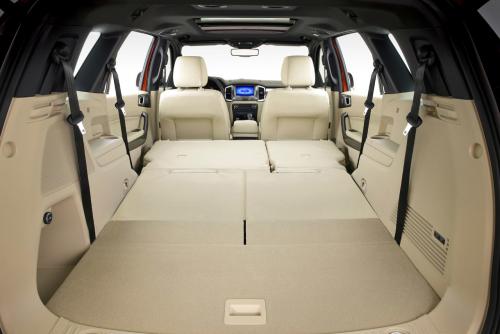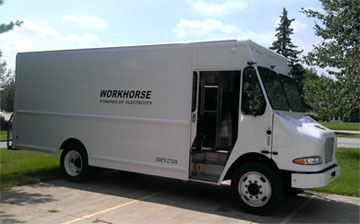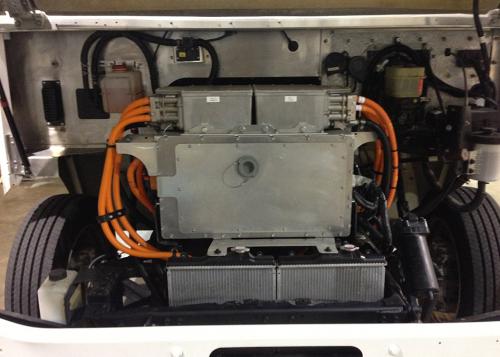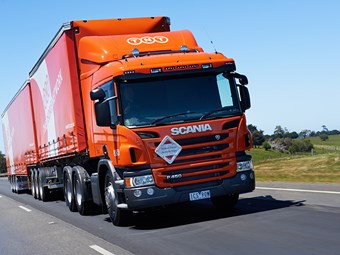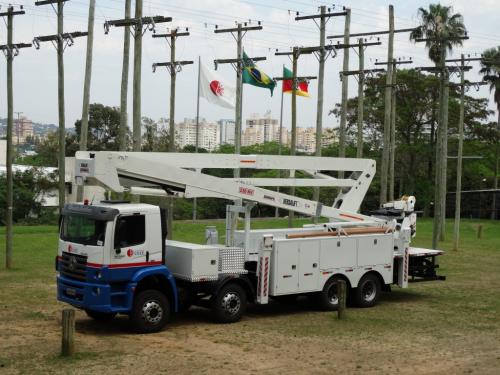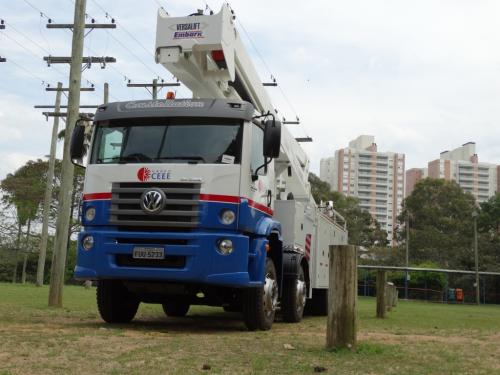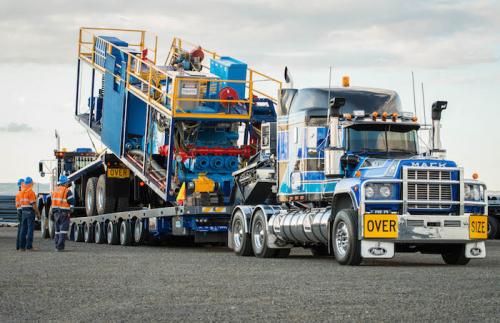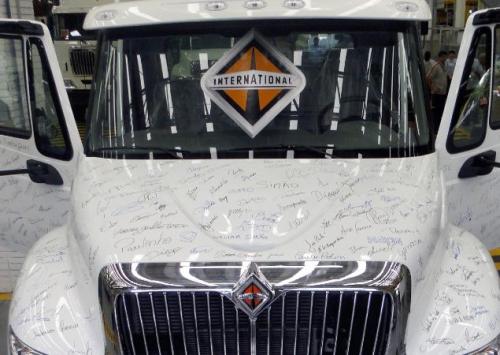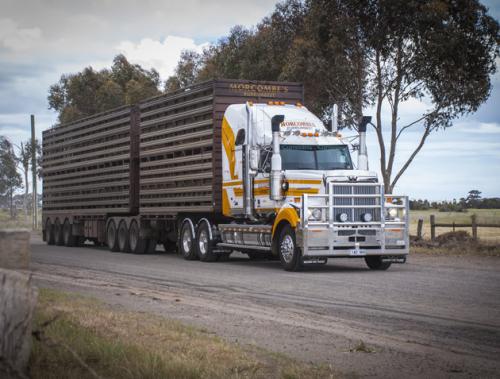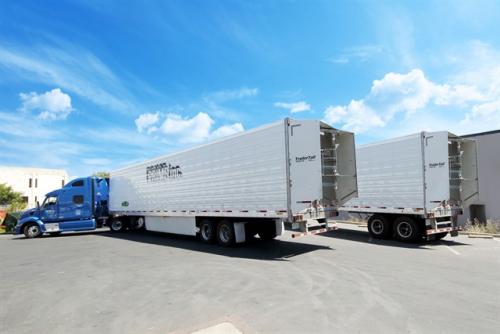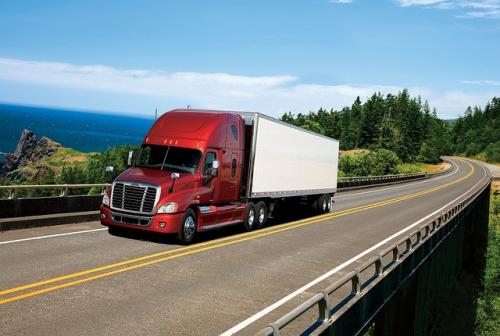
kscarbel2
Moderator-
Posts
18,876 -
Joined
-
Days Won
114
Content Type
Profiles
Forums
Gallery
Events
Blogs
BMT Wiki
Collections
Store
Everything posted by kscarbel2
-
Trailer/Body Builders / November 19, 2014 Following the agreement on the acquisition of the leaf spring and stabilizer segments of the Austria’s Frauenthal Group in June 2014, a deal expected to close at the end of 2014 or early 2015, Hendrickson has entered into an agreement to sell its 50% stake in Muelles y Ballestas Hispano-Alemanas, S.A. (MBHA) to the other 50% shareholder, InvestZiur, in November 2014. As a result, both Hendrickson and MBHA will be able to independently pursue their own business strategies. When these transactions are complete, MBHA will be wholly-owned by its founding shareholders, InvestZiur, and the Frauenthal Group’s leaf spring and stabilizer business will be wholly-owned by Hendrickson. Hendrickson, a Boler company, is a leading global manufacturer and supplier of medium- and heavy-duty mechanical, elastomeric and air suspensions; integrated and non-integrated axle systems; auxiliary lift axle systems; parabolic and multi-leaf springs; and bumper and trim components to the global commercial transportation industry. Hendrickson, is based in Itasca, Illinois. www.hendrickson-intl.com. FYI: The MBHA-Hendrickson joint venture in Valencia, Spain has for years quietly designed and produced most of the suspensions for the European truckmakers. A rarity, an American truck component supplier doing robust business in Europe, Hendrickson designs and manufactures unique proprietary designs for each European truckmaker. Hendrickson’s advanced metallurgy research allows the company, for example, to supply strong but lightweight mono-leaf steer axle springs to Mercedes-Benz and others.
-
Following a long period of silence about a promised diesel option for the new 2014 Chevrolet Colorado and GMC Canyon, GM is displaying a concept truck fitted with the 2.8-liter Duramax diesel (XLD28) at the Los Angeles Auto Show (November 18-20). Available since 2011 in the global market, the powerplant is rated at 181 horsepower and 369 pound-feet of torque at 2,000 rpm. The in-line four cylinder engine is mated to a six-speed automatic transmission. No manual tranmssion is offered*. * Overseas, a manual transmission is available with the 2.8-liter Duramax, but torque is cut back from 369 to 324 lb/ft. The 2.8-liter Duramax double overhead camshaft (DOHC) engine was developed at Italian diesel engine maker VM Motori*, where it is known as the model A428. Produced in Rayong, Thailand, it features an 1800 bar common rail injection system with piezo-electric injectors and a variable-geometry turbocharger (VGT). * In 2003, Penske purchased a 51% stake in VM Motori. In 2007, Penske bought the remaining 49% from DaimlerChrysler and subsequently sold 50% of it to GM. In 2013, GM sold its 50% stake to Fiat. The new-for-the-US Colorado/Canyon in 2014 went into production first overseas in 2011, where it available with both 2.5- (XLD25) and 2.8-liter displacement Duramax engines. In 2013, the second generation Duramax engines went on sale overseas, delivering 11% more power and 6% more torque, while consuming 4.3% less fuel. A new high pressure fuel pump for the common rail injection operates up to 2,000 bar, up from 1,800 bar. The global market 2.5-liter Duramax went from 150 to 163 horsepower while the 2.8-liter went from 181 to 200 horsepower. FYI: GM has had an on-again, off-again plan (due to financial woes) to offer a 4.5-liter Duramax 72-degree V-8 (code-named LMK) in its full-size half ton trucks. A project cancelled in 2009, GM Vice President of Global Powertrain Steve Kiefer said this year the words “dust off” the 4.5L diesel engine have been mentioned quite a bit. Featuring a 2000 bar common rail injection system with piezo-electric injectors and a variable-geometry turbocharger (VGT), the 32-valve double overhead camshaft engine (DOHC) was expected to produce 310 horsepower and 520 pound-feet of torque. In comparison, Fiat-Chrysler’s VM Motori-produced 24-valve double overhead camshaft engine (DOHC) 60-degree V-6 EcoDiesel produces 240 horsepower and 420 pounds-feet of torque (The 60-degree angle serves to reduce the vibration associated with V-6 configurations). The 4.5 does not have intake manifolds. It uses a unique head design in which the intake portion is located on top of the cylinder head while the exhaust manifolds exit into the engine valley. The engineering goal is to increase the thermal efficiency of the turbocharger (located in the engine valley). The engine utilizes a Compacted Graphite Iron (CGI) engine block paired with aluminum cylinder heads. The 4.5 was allegedly developed by GM in-house, without cooperation from Isuzu or VM Motori (given GM's history with self-designed diesels, not necessarily a good thing).. Little known facts: Holding a 50% stake in VM Motori at the time, GM and the Italian diesel engine maker were designing a 3.0-liter diesel for Cadillac’s European market ATS, CTS and SRX. GM fell into financial woes and cancelled the project in 2009. After Fiat bought GM’s stake in 2013, they completed the 3.0-liter diesel project and it became the EcoDiesel available today in Dodge (Ram) half ton pickups and Jeep Grand Cherokees. Owners of those vehicles may be intrigued to know that the development of their engine was funded by General Motors (a.k.a. Government Motors). .
-
Today's Trucking / November 19, 2014 Manitoba Infrastructure and Transportation has signed a Western Memorandum of Understanding (MOU) on Rocky Mountain Doubles (RMDs) and is ready to proceed with implementation. "We have been in communication with Manitoba Infrastructure and Transportation Motor Carrier Permits staff and they have confirmed they are ready today to issue permits for RMDs based on the specifications of the new MOU," says Terry Shaw, executive director of the Manitoba Trucking Association. And that means that RMDs can now travel on established routes at a maximum length of 134 feet on multi-lane highways, and 106 feet on two-lane highways. In Manitoba, that now includes the full-length of Highway 16 through to the Saskatchewan border. Opening up Highway 16 to the Saskatchewan border will allow carriers to haul RMD combinations from Winnipeg directly through to Northern Saskatchewan and Alberta. Or in other words, truckers and their customers will get more operational and cost efficiencies and could even reduce greenhouse gas emissions.
-
Overdrive / November 17, 2014 A Final Rule mandating the use of electronic logging devices by drivers and fleets is expected to be published Sept. 30, 2015, according to a recent Department of Transportation report, meaning enforcement of the mandate would begin Sept. 30, 2017. That publication date is a projection, included in the DOT’s monthly regulatory update. The report also says a projected rule to mandate the use of speed limiters will be sent from the DOT to the White Houses’ Office of Management and Budget next month, in line for a March 16 publication date. That projected rule’s action dates, however, have been pushed back several times this year already. Here are the projected dates for other upcoming regulations included in the report: Liability insurance increase: Still projected for publication this month is an Advanced Notice of Proposed Rulemaking regarding the minimum amount of liability insurance that motor carriers must have. The ANPRM will likely be simply a questionnaire for carriers that will be used as a data gathering tool for the agency and not a rule intended to raise the current minimum. The agency still would have to produce a Notice of Proposed Rulemaking and accept public comment before crafting a Final Rule. Safety Fitness Determination: The DOT also projects in its report that FMCSA’s long-awaited Safety Fitness Determination rule will be published in April as a NPRM. The rule, once final, will allow the agency to use the data at its disposal to create absolute scores for carriers, which would be used to target them for intervention. The DOT projects a publication date of March 24. The rule will be sent to the OMB Dec. 23, according to the projection, and clear the OMB March 24. CDL Drug and Alcohol Clearinghouse: The Clearinghouse would establish a database of drives who have failed or refused to take a drug or alcohol test. The rule is scheduled to be published as a Final Rule in October 2015. It was published as a proposed rule this year. Driver coercion prohibition rule: This rule would prohibit carriers, brokers and others from coercing drivers to violate federal rules, like hours of service. It is scheduled to be published as a final rule Sept. 10, 2015. It was published as a proposed rule this year.
-
Tested in Arizona, USA............but you can't buy one. Ford has all the business they need? Based on appearance, functionality and specs, the 2015 Ford Everest is a truck that I would buy (with one of the two offered diesels). I wouldn't even consider the current Explorer. And yes, Toyota is thrilled that the Ranger is gone.
-
Fleet Owner / November 14, 2014 The new Detroit Assurance integrated safety system will be made available by Daimler Trucks North America (DTNA) on select Freightliner tractor models in the first quarter of 2015. Introduced at the American Trucking Associations (ATA) annual convention in October, Detroit Assurance integrates radar and sensor technology with Detroit engines and transmissions as well as a truck’s brake system to offer active brake assist (ABA) and active cruise control (ACC) capability. While Brad Williamson, DTNA’s manager of powertrain marketing said that the company still plans to still offer similar safety technology such as Meritor’s OnGuard package as options on DTNA-brand heavy trucks, he believes the ability to better integrate Detroit Assurance with DTNA components is the major advantage of the new proprietary system. “It’s really about the feel, the smoothness, and how we can better integrate the intelligent controls with the truck,” Williamson explained here during a press conference with reporters. “That’s the main piece.” Detroit Assurance will also be available with an optional camera system that offers lane departure warning (LDW) capability as well, he pointed out. Williamson stressed that Detroit Assurance will initially only be available on 2016 Freightliner Cascadia and Cascadia Evolution tractor models equipped with Detroit engines and the company’s DT-12 automated manual transmission (AMT) or manual transmissions. He added that Detroit Assurance will also be “price competitive” with comparable systems available on the market. Detroit Assurance is referred to as a “safety suite” by DTNA and use cab-mounted radar and optional cameras to warn the driver or, if necessary, slow the truck down automatically. Scott Keebler, DTNA’s GM of component sales, noted that ABA follows a three step process to help mitigate potential collisions. First, it mutes the radio if in operation while sounding an audible warning as well as flashing a visual warning to the driver. If no action is taken, partial braking is engaged with ‘tactile’ warnings given to the driver. Finally, if a collision is imminent, the system will fully engage the transmission, engine brake and service brakes. Keebler pointed out that ACC piece of the Detroit Assurance package activates when the vehicle exceeds 37 mph and can be set to offer from 2.3 to 3.5 seconds worth of following distance. A 15 minute disable switch gives drivers the ability to deactivate ACC when in construction zones and the like, with cruise control re-engaging following that 15 minute interval when the vehicle hits 47 mph. He added that the optional camera system provides audio and visual indicators to notify a driver if and when they unintentionally depart from their lane, with the system again muting the radio if playing and then generating audible warnings on the side of the vehicle where the lane departure occurs. Williamson noted that Detroit Assurance represents 18 to 20 months’ worth of development to this point, including two winter and two summer test cycles. He added that customer demonstration trucks models equipped with Detroit Assurance are expected to hit the road by the end of November this year. http://fleetowner.com/safety/digging-detroit-assurance#slide-0-field_images-142591
-
The new Colorado and Canyon are attractive trucks. But fuel economy is mediocre and the promised diesel engine option remains elusive. Most of all, its hard to buy a GM product. GM remains focused on cutting costs to survive, equating to the cheapest possible parts. And at the end of the day, Fords continue to display greater durability, and thus greater resale value.
-
EPA Settlement with Mack Trucks Inc. Protects Environment
kscarbel2 replied to kscarbel2's topic in Trucking News
Typically arrogant Volvo stance. Mack (Volvo Group) did not admit liability for the alleged violations, the EPA said. "It's important to emphasize that these administrative errors did not harm our people, our neighbors or the environment," Mack spokesman Christopher Heffner said. http://www.mcall.com/news/local/eastpenn/mc-mack-trucks-epa-settlment-20141113-story.html -
The all-new in 2011 Ford global market ranger is superb. It's a cutting edge design from bumper to bumper. Ford's thought process that the Ranger would steal market share from the F-150 isn't just flawed, it is absurd. The Ranger and F-150 would have uniquely different US market customers. Better looking than today's Grand Cherokee (and without the ridiculous price tag), the Ford Everest would sell well in the US market.
-
EPA Settlement with Mack Trucks Inc. Protects Environment
kscarbel2 replied to kscarbel2's topic in Trucking News
Quite a long lost of environmental violations by Volvo. Clearly the Swedish truckmaker doesn't have the best interest of the Lehigh Valley's environment in mind. For Volvo to ignore so many U.S. EPA regulations (for the sake of profitability.........for as long as they can get away with it) isn't surprising though. 1. Operating a hazardous waste storage facility without a permit or interim status 2. Maintaining an open container of hazardous waste 3. Failure to comply with regulations on hazardous waste marking and record-keeping 4. Failure to comply with contingency planning safeguards 5. Failure to provide hazardous waste training to employees 6. Failure to maintain documents and records for hazardous waste training 7. Failure to comply with contingency plan requirements 8. Failure to maintain a tank certification. -
Ford introduces all-new mid-size Everest SUV November 13, 2014 The new 2015 Ford Everest is based on a stretched version of the popular global market Ford Ranger pickup truck. The Everest is available with a range of engines including a gasoline 2.0-liter EcoBoost turbocharged four-cylinder, and two Duratorq turbodiesels – a 2.2-liter four-cylinder and a 3.2-liter inline five-cylinder – mated to a six-speed manual or automatic transmission. Both rear-wheel-drive and shift-on-the-fly four-wheel-drive variants are offered. The Ford Everest competes with Toyota Land Cruiser Prado (known as the Lexus GX in the US market) and the Jeep Grand Cherokee. With its body-on-frame construction, the new Everest offers rock-crawlers serious off-road capabilities. The Everest has nearly nine inches of ground clearance, over 30 inches of wading depth, a 29-degree approach and 25-degree departure angles. The seven seat cabin features flat-folding second and third rows, a Sync 2 infotainment system with an 8-inch touchscreen, active noise control, an optional moonroof and the full spectrum of electronic safety features including autonomous emergency braking, blind-spot monitoring, lane departure and lane-keeping systems. There is an internal argument at Ford over whether or not to sell the Everest in America. The Everest’s body-on-frame construction, like Toyota’s 4Runner, is clearly different from Ford’s similarly sized soft off-roaders, the Flex and Explorer, which share Ford's D4 unibody platform. Only the larger Expedition offers body-on-frame construction (the older-than-dirt Expedition's V-8 is replaced by a V-6 EcoBoost for 2015, and receives minor trim changes). .
-
Fleet Owner / November 13, 2014 Since its purchase of the Workhorse brand from Navistar in late 2012, Amp Holding, parent company of Amp Trucks, has been working towards electrifying the step van chassis. With the announcement on Wednesday that a “major transportation company” had ordered 18 of its all-electric Workhorse E-100 walk-in vans, that process is taking its next steps. But it’s not just in the electric truck market that Amp wants to play, the company is also looking to become a provider of delivery drones. And CEO Steve Burns told Fleet Owner in an exclusive interview that Amp expects to succeed in the marketplace where others have faltered, and even failed. “First off, nobody built their own chassis,” he said. “They all retrofitted a chassis. Azure Dynamics retrofitted the Ford chassis. Smith Electric imported a chassis from the Czech Republic. The second thing is the batteries. None of those guys controlled their batteries. They essentially outsource their batteries (and battery systems) and used automotive (systems). Tesla uses commodity batteries and built (a system) around it. We did the same thing. We’ve built a system around commodity batteries. The E-100 van features a 100 kWh Lithium battery pack featuring Panasonic 18650 cells, the same battery cells used by Tesla in its vehicles, that “provide power to a 2200 nm permanent magnet motor powerful enough to eliminate the need for a transmission,” Burns said. There are a few keys to the vehicle, Burns relates, that he believes will make it a fleet success. First, the use of the batteries, which Panasonic “literally makes a billion of a year,” keeps costs down on that front due to the scale of production. Second, the elimination of a transmission altogether saves weight, meaning that less battery power is needed to move the vehicle so Amp could “right-size the battery pack,” Burns noted. And finally, the debut of the vehicle follows Amp’s purchase of the Workhorse brand and manufacturing facilities from Navistar in 2013 when that company was going through its financial problems. With the Workhorse chassis and technologies in-house (Burns said Amp will begin offering traditionally fueled Workhorse chassis later in 2015), Amp was able to build a new “narrow track W88 chassis” for the electric vehicle. That was a game-changer, Burns said, because previously electric vehicle makers retrofitted chassis to their systems. The Workhorse chassis is purpose built for electric power. The choice to go with Panasonic battery cells is also helping Amp reach customers. “Once we tell people we are using Panasonic batteries just like Tesla, the battery discussions (and concerns) are over,” Burns said. Burns added that because “transmissions are energy-robbing and a maintenance headache,” the elimination of this traditional vehicle component, while also reducing weight, is another bonus. “To lose that … is a game-changer,” he said. The E-Gen system itself is unique in that it uses a generator to provide “emergency” backup power when needed. “Typically [step vans] go 50 or 60 mi. a day, but everybody puts in batteries that can go 100 mi.,” Burns said. “We also saw that these vehicles typically stop a lot during the day. The generator only runs when the vehicle is turned off.” The way the system works, Burns explained, is the vehicle operates on electric power during its operation. But, because the range of the batteries is lower to match a typical daily route, the potential to run out of electric power exists. To combat that, Amp developed the E-Gen. The E-Gen is similar to a small stationary generator and operates on gas, natural gas or propane. When the van is turned off, the system checks the battery levels and if needed, turns on the 25-hp. generator to recharge the batteries. “Only a small amount of fuel is needed,” Burns said. “But in a typical day, the E-Gen probably would not be needed.” The end result is, again, a smaller, lighter system that is also lower priced, resulting in a three-year payback on the vehicle. The E-100, though, is not Amp’s only foray into advanced electric technology. The company is also preparing the “Horsefly.” The Horsefly is a battery-powered unmanned aerial vehicle (UAV). It is similar to Amazon’s drone delivery concept in that it will deliver packages to front doors. Unlike Amazon’s idea, which dispatches drones from centralized warehouses, Amp’s Horsefly sits atop a delivery vehicle in a “portal.” “[Amazon’s] model, with a centralized warehouse and drones flying out of that, we don’t think that will work because of the [battery] weight needed [to fly distances],” Burns said. “This is really a mobile warehouse. “In the end, these things are electric, so the battery is key,” Burns added. “Most of what is out there is ‘hobby grade,’ what we’re building is commercial grade.” The eight-rotor drone is being developed in conjunction with the University of Cincinnati’s Dept. of Aerospace Engineering and Engineering Mechanics. Burns explained that the drone sits on top of a vehicle, charging when not in use. A driver can than walk back into the cargo area, pick up a package and pass it up through the portal to the drone, which clamps onto the box (up to 10 lbs.), reads the barcode to locate the delivery address, and then flies off. While the drone is making its delivery (being guided by a “pilot” back at a call center to ensure the package is landed safely in the appropriate spot), the driver can get back into the driver’s seat and go on to his next delivery, improving efficiency. When the drone has completed its task, it locates the current location of the vehicle and returns to the portal atop the roof, ready for its next delivery. “It’s not going to be for every delivery,” Burns said, “but there are ones where it will make sense.” The commercial use of drones is currently restricted by law, Burns said, but there is hope that the government will change the regulations by next summer to allow their use. If that happens, Burns said Amp’s Horsefly will be ready to deliver. .
-
Australasian Transport News (ATN) / November 14, 2014 The first fleet delivery of Euro 6 (EPA2010) emissions-level trucks has just taken place down under in Australia. TNT Australia just received five P450 prime movers that will work double shifts of metro pickup and delivery during the daylight hours and regional freight runs at night. These Scania units use a 13-litre 6-cylinder that relies on both exhaust gas recirculation (EGR) and selective catalytic reduction (SCR) to reduce emissions. This engine is touted to be a rather torquey little unit with peak torque at 2,350Nm (1,733lb/ft) from 1,000rpm to 1,300rpm. The engine is backed by Scania’s Opticruise 14-speed (12+2) automated manual transmission (AMT). Euro 6 regulations mean that nitrogen oxide needs to be reduced by one fifth from current Euro 5 (EPA2007) levels. Particulate also needs to be reduced to satisfy Euro 6 as well. In most cases this means that the engine requires a combination of the EGR and SCR. That said, Scania and Iveco both have Euro 6 compliant engines that use SCR only (no EGR). EGR gets a bad rap from a lot of operators that have been stung by their association with this technology. However, in a Euro 6 application the EGR system is working at a much reduced flow rate as the SCR system is chipping in to help as well. Weight and fuel consumption are a concern for some, yet Scania claims that this Euro 6 engine will equal if not better it’s Euro 5 equivalent. TNT Australia is no stranger to cleaner and greener technologies boasting one of the biggest hybrid fleets in the country. "We already run Australia’s largest hybrid truck fleet, and a recent four-year internal study found that our 30 hybrid trucks have emitted 112 fewer tonnes of CO2 into the atmosphere than comparable diesel-powered trucks over that period," TNT national fleet and equipment manager Kurt Grossrieder says. "Recently we commissioned another 24 hybrid trucks to further reduce our total output of greenhouse gases while using less fuel, which is a positive step for TNT and the environment." TNT has also been conducting its own CNG trial with its Canberra-based fleet. On the eve of these new trucks joining the TNT fleet in Melbourne we had the opportunity to take one for a spin at its typical working weight. There were a couple of firsts here for us, the first real world drive of a Euro 6 truck on the road and the first time I’d dragged a B-double with Scania’s P-series. Our bright-orange combination tipped the scales at 46 metric ton gross (101,413lb)), a typical TNT B-double working weight. There were a couple of unique TNT aspects to the truck aside from the colour. First, the company had specified the low-to-the-ground P cab and, second, the fitment of a very meaty staircase and handrail to the driver’s side of the prime mover chassis. It’s very clear from just looking at the truck everything has been about making the drivers life safer and easier in a multi trailer drop situation. The stairs also stop drivers from climbing onto a very hot after-treatment box to gain access to the chassis. Our test route took us on a return trip from Laverton to Ballarat, a distance of 221 km. My main interest was in the performance of the engine under load. The 6-cylinder had quite a bit of torque on tap considering its displacement and it held its own climbing the Pentland Hills out of Bacchus Marsh. I kept the tranny in its standard shift point setting and in rumbled up the grade in 9th gear 1,300rpm. The climb out of Pykes Creek also saw the tacho needle glue itself to 1300rpm in 8th gear. As with much of the Euro product on the market now it’s all about the torque and low revs. My fuel over the route was 1.83km/l, which isn’t too shabby for a light double on those grades with virtually no kilometres the engine. The low P cab is great for this kind of round town application. On the whole, the Euro 6 Scania P Series appears to have just what it takes for TNT. .
-
Newsroom - U.S. Environmental Protection Agency (EPA) / November 13, 2014 In a settlement with the U.S. Environmental Protection Agency, Mack Trucks Inc. has agreed to properly manage the hazardous waste at its truck assembly plant in Macungie, Pa. Mack Truck, located at 7000 Alburtis Road, Macungie, Pa., has also agreed to pay a $54,800 penalty to settle the alleged violations of hazardous waste regulations. EPA cited Mack Trucks for violating the Resource Conservation and Recovery Act (RCRA), the federal law governing the treatment, storage, and disposal of hazardous waste. RCRA is designed to protect public health and the environment, and avoid costly cleanups, by requiring the safe, environmentally sound storage and disposal of hazardous waste. After a facility inspection, EPA cited the company for several RCRA violations involving hazardous waste stored at the facility, including solvents and paint wastes. The alleged violations included: operating a hazardous waste storage facility without a permit or interim status; maintaining an open container of hazardous waste; failure to comply with regulations on hazardous waste marking and record-keeping; failure to comply with contingency planning safeguards; failure to provide hazardous waste training to employees; failure to maintain documents and records for hazardous waste training; failure to comply with contingency plan requirements; and failure to maintain a tank certification. The settlement penalty reflects the companys compliance efforts, and its cooperation with EPA in the resolution of this matter. As part of the settlement, Mack Trucks has not admitted liability for the alleged violations, but has certified its compliance with applicable RCRA requirements. For more information about hazardous waste and RCRA, visit http://www.epa.gov/epawaste/hazard/index.htm.
-
Press Release / November 11, 2014 Already offering factory-installed mixer, tipper, refuse and beverage bodies, VW’s vocational truck unit is now offering a range of aerial lift trucks. The flagship of the line-up is based on the company’s 26.280 8x4 vocational chassis and features an Embark service body paired with an insulated, articulated and telescopic VersaLift model VST-9000-MHI with a 29 meter (95 foot) working height able to reach high voltage transmission lines. http://www.versalift.com/Equipment/Info/VST-9000-MHI http://www.embark.com.br/eletrificacao.htm Customized for electric utilities, the first production unit has been delivered to CEEE Group, a power and energy company based in the Brazilian city of Rio Grande do Sul. Prior to body installation, wheelbase lengthening and other custom modofications to meet customer requirements were performed by Volkswagen’s in-house factory modifications center. VW’s 26.280 8x4 vocational chassis is powered by a Euro-5 (EPA2007) emissions 6.9-liter 275 horsepower MAN D08 engines paired with either a 16-speed ZF 16S1455TD manual transmission, 12-speed ZF 12AS1630TD AS Tronic AMT or six-speed Allison 3000 series transmission. With the addition of aerial lifts to its vocational range, Volkswagen plans to aggressively target new business in the energy sector. "With higher and more sophisticated power transmission networks, a new demand is being created for equipment of this size. With the ability of our factory mod center to offer customers turn-key customized truck and body configurations, we are positioned to serve this promising market,” says Ricardo Alouche, vice president of Sales, Marketing and After Sales at MAN Latin America. .
-
Diesel News Australia / November 11, 2014 After many weeks of rumour and speculation, the long awaited announcement of the deal between McAleese and Heavy Haulage Australia has gone public. McAleese Group is to acquire 50 per cent of HHA Group, specialists in heavy haulage transport and lifting covering all facets of the industry, including transportation, cranes, electrical wire/transport escort services, storage support and self propelled modular trailer (SPMT) logistics. The company, featured in the Megatruckers TV series, employs more than 120 people at sites in Brisbane (head office), Toowoomba, Darwin, Port Hedland, Perth and Adelaide. HHA have grown rapidly as heavy haulage and lifting tasks for the infield oil and gas sector have grown. According to a statement from McAleese, “The alliance with McAleese Heavy Haulage & Lifting, in particular further strengthens their ability to serve the larger project logistics tasks in these sectors across a national network. “The strategic equity investment presents an opportunity to build upon McAleese’s existing skills, broaden the customer base and leverage the businesses combined assets into new markets and significantly improve utilisation in the Heavy Haulage & Lifting division.” A statement from HHA tells us, “The outcome of this transaction will see Heavy Haulage Australia cement its standing as the country’s premier heavy haulage logistics provider and ensure its innovative and market leading approach to safety, equipment and overall operations will continue for years to come. HHA Managing Director, Jon Kelly, and his existing management team will continue to control and operate the business with the McAleese Group. The deal gives the McAleese Group an option to acquire the remaining 50 per cent of HHA within two to five years of this initial equity investment. “I am very excited by the prospect of this partnership which combines the operations of HHA with the McAleese Heavy Haulage & Lifting division to provide a formidable national service offering within the Australian heavy haulage marketplace,” said Kelly. “HHA has been very successful over the past two years in diversifying its portfolio of work and securing long term contracts. However, this success has seen a need for additional capital investment to ensure we continue to provide the highest standard of company owned assets to all new and existing clients. “We will also be looking to leverage the extensive McAleese Heavy Haulage & Lifting fleet to assist us in furthering our service offering to our clients in a vast array of locations across Australia. The on road, heavy lift and corporate support that McAleese can offer HHA will only allow us to further flourish within our defined chosen markets” From a single operator in 1999, HHA, with the enigmatic Kelly at the helm, has grown to become one of the largest heavy haul fleets in Australia with over 65 prime movers, over 760 axle lines of trailers and 18 cranes. “The past five years at HHA have been an amazing success story, our growth through trying times is a credit to our great customers and our professional staff,” said Kelly. “Our strategic partnership with McAleese allows me to keep pushing our vision and service offering with the added benefit of their asset base and financial capability, HHA is not a small business anymore and it is exciting to recognise that the brand will flourish for many, many years to come.” http://www.youtube.com/watch?v=X8jAH_A0dHs#t=64 .
-
Bloomberg / November 11, 2014 Ford Motor Co. Executive Chairman Bill Ford talks about the automaker's revamped Rouge factory in Dearborn, Michigan, the new aluminum-bodied F-150 pickup, Ford's U.S. workforce and hiring plans, and overseas sales of the redesigned Mustang model. Bill Ford also discusses the company's performance in Europe, currency issues and the impact of gasoline prices on truck sales. http://www.bloomberg.com/video/bill-ford-on-new-f-150-pickup-u-s-workforce-europe-NfpLxK40SBadpqqMP1cAhg.html
-
iTrucks Icarros / November 10, 2014 Navistar produced its 1,000 truck at the company’s plant in Canoas, Rio Grande do Sul, Brazil. Truck assembly at the 129,000 square foot plant began in June 2013. Navistar produces the 9800i COE and 4400i (DuraStar) at Canoas. The 9800i is offered in 6x2 and 6x4 configurations Eaton manual and AMT transmissions. With a heat treated frame and aluminum cab, the 9800i one of the lightest tractors in its class. The 9800i's 410 horsepower Cummins ISM powerplant is paired with a Cummins C-Brake developing up to 395 braking horsepower. Spec’d with the UltraShift Plus AMT, the 9800i is the only truck in Brazil offering an 18-speed transmission. http://www.internationaltrucks.com/brazil/trucks/9800i The 4400i DuraStar is produced in 4x2, 6x2 and 6x4 variants and features a 274 horsepower MaxxForce 7.2-liter (MWM Acteon 6.12TCA) diesel engine supplied by Navistar’s engine producing MWM-International Brazilian subsidiary. http://www.internationaltrucks.com/brazil/trucks/durastar http://www.internationaltrucks.com/NC2Brazil/Engines/MaxxForce?lang=en .
-
Brockway progress
kscarbel2 replied to 6368's topic in Antique and Classic Mack Trucks General Discussion
The Rockwell AC6 six-rod suspension was extremely popular down under. Demand was so great amongst long-time users that it remained a factory option on Australian Mack trucks at least thru 2007. . ArvinMeritor AC6 Series 6-rod suspensions.pdf -
Truck World Australia / November 6, 2014 The history of the Morcombe’s Farming and Transport enterprises dates back to early this century when Arthur Morcombe started the farm as a First World War settler. The transport division of the business was born soon after, initially responsible for delivering supplies to build some of the very first roads in the district which then lead onto carting produce and livestock thereafter. The original farm, located just outside Ballarat at Burrumbeet, remains to this day and has steadily expanded to become a mixed farm that includes merino sheep and Hereford cattle as well as crops such as wheat, barley and canola. Today the farm and transport divisions operate as separate businesses owned and operated by family members. Morcombe’s Transport, which Mark and cousin Stephen look after, is mainly involved in livestock transport covering a wide area that can include both short local trips to sale yards through to long haul interstate trips to places such as Dubbo NSW to collect livestock. “One of the key things I was looking at in a new truck was a spacious sleeper cab. Being a driver myself, I know how important it is to be able to stand up and walk around in the cab after a long drive. Also to have plenty of storage space and room for all your personal possessions and things like a fridge. Western Star’s roomy 54 inch ‘stratosphere’ cab satisfied all those requirements,” Mark said. The other criteria that Mark had was for an engine with Selective Catalytic Reduction (SCR) technology and that’s where Cummins latest engine, the ISXe5, fitted the bill perfectly. The SCR exhaust after treatment on the ISXe5 is a fully integrated system developed by Cummins Emissions Solutions (CES), dosing urea into the exhaust stream to reduce oxides of nitrogen (NOx) emissions. The ISXe5 has the same base engine design as the current Cummins EGR engines but incorporates a new common rail fuel system, a wastegate turbocharger and a single overhead camshaft. The Cummins XPI* (extra-high pressure injection) common rail fuel system provides very precise injection and combustion control. It operates independently of engine speed and provides injection pressures greater than 30,000 psi. “I’ve always been a fan of Cummins engines and so the new 15 litre ISXe5 engine was the obvious choice,” Mark went on to say. After driving the Western Star for a few months Mark reports that he’s very happy with it. “I’m really pleased with it. The performance and fuel economy are both excellent. It drives really well on the road and despite its sizeable length, I find the maneuverability very good too,” Mark added. Mark dealt with James Leo at Westar Truck Centre and in his own words the purchase experience went 'nice and smoothly' with Mark returning to Westar for the first oil services. “Given the truck is away for long periods of time I had an auto greaser fitted which provides me with added peace of mind between services," said Mark. With three young sons, Mark has high hopes that both Morcombe’s Farm and Morcombe’s Transport will be around long into this century. Western Star 4900FXT - Specification Sheet * Cummins-Scania XPI Manufacturing LLP is a 50/50 joint venture that designs, develops and manufactures next generation fuel systems. Locations include Columbus, Indiana, Sodertalje, Sweden and Juarez, Mexico. Cummins and Scania first began to jointly develop high pressure fuel injection systems in 1992. The two companies went on to form the Cummins-Scania High Pressure Injection LLC joint venture in 1999 for the production of HPI (high pressure injection) systems. .
-
Australasian Transport News (ATN) / Novermber 7, 2014 Fuso has made some modifications to its automatic transmissions* after reports of lost momentum during gear changes in some conditions. The change affects all rigid models built from November 2013 on, and all prime-movers built since May 2014. Vehicles built before these dates will require a change of the transmission ECU to benefit. "We recently updated the transmission program in our FV Series prime mover, and one driver reported that it was like he had been given a new truck," Fuso product planning engineer Kevin Johnston says. The two main changes are shortened clutch engagement phase timing and an improved shift map when in 'drive'. The former is to allow for a faster gear-shift, whilst the latter is to allow transmission ‘down’ changes at higher revs whilst the vehicle is decelerating. "We have also changed the steering feedback in our 6x4 models," Johnston says. "Over a period of time, we received feedback from customers saying the steering felt ‘a bit vague’ at highway speeds. "We have responded by designing more pre-load into the system which now gives a more solid steering feel when driving at or near the speed limit," Kevin Johnston said. The steering change applies to all 4x2 and 6x4 trucks built on, or after March 2014 in Japan. http://cdn.fuso.com.au/Docs/SpecSheets/FV54_Prime_Mover.pdf * Mitsubishi FV Series heavy tractors are equipped with a variant of the last generation Mercedes-Benz 12-speed PowerShift AMT (automated manual transmission), paired with the older 11.97-liter OM457LA related to the 12.0-liter Detroit Diesel Series 55 and 12.8-liter MBE4000 (OM460LA) once sold stateside. .
-
Heavy Duty Trucking / Novermber 7, 2014 Prime ordered 2,500 TrailerTail aerodynamic devices from ATDynamics to be installed on its new Utility refrigerated trailers. It is the largest order in ATDynamics company history. “We confirmed TrailerTail fuel efficiency in 2012 at the Goodyear Proving Grounds and have already deployed over 1,800 TrailerTails in our fleet,” said Paul Higgins, director of maintenance at Prime. “We have been very pleased with the product’s overall performance and have now made TrailerTail technology a standard specification for all new trailers.” The two companies worked closely together to deploy the devices in Prime’s trucking fleet and Prime has since made ATDynamics its preferred provider of rear-drag aerodynamics devices. “Prime is a forward thinking company and has seized this opportunity to gain a competitive edge from increased profits both for itself and its drivers, while simultaneously reducing the carbon emissions of its fleet,” said Andrew Smith, CEO and founder of ATDynamics. Prime’s trailers equipped with TrailerTails and skirts will qualify for SmartWay’s highest efficiency category, according to ATDynamics. The distinction is given to vehicles getting 9% or better fuel savings from trailer aerodynamics. .
-
Fleet Owner / November 7, 2014 Even as the strengthening economy keeps driving up demand for both new and used trucks, the average age of fleet vehicles continues to trend up, according to Gary Meteer, director of commercial vehicle solutions for IHS Automotive, which provides research and analysis services. While registrations for used trucks still outnumber those for new ones, overall demand for commercial vehicles in both the U.S. and Canada “continues to strengthen,” Meteer stated in his remarks this week at the Automotive Aftermarket Products Expo (AAPEX) in Las Vega. “With more than 7.7-million commercial vehicles on the road in the U.S., the market here is at its highest levels since the 2008-09 economic downturn,” he pointed out. More specifically, Meteer said that Class 8 vehicles “continue to dominate both the U.S. and Canadian markets,” accounting for more than a 50% share of new registrations in the U.S. and over 60% in Canada. On the other hand, he stressed that “with the overall market recovery, Class 5 straight trucks and chassis-cabs have been in high demand for modifications and use in the wholesale, retail and service industries. “In the current calendar year, the demand for these vehicles is at record levels.” As Meteer put it, it’s “not surprising” that the recovery in the commercial vehicle market in both countries is being “largely driven by the business community.” He said U.S. businesses have accounted for more than 90% of new vehicle registrations so far this year. According to IHS Automotive, the south and central regions of the U.S. stand out as the strongest markets for trucks, representing more than 62% of new vehicle registrations so far this year. In Canada, the four provinces of Alberta, British Columbia, Ontario and Quebec “account for more than 87% of new commercial vehicle registrations and additional growth is expected.” Then there are all those aging trucks. Metter said “the average age of commercial vehicles in the fleet is shifting.” IHS Automotive has determined that while the average age for Class 4-8 vehicles was 12.5 years in 2007, that figure now stands at 14.7 years. What’s more, the subset of Class 6 vehicles is averaging 20.9 years -- the highest in the fleet. Conversely, the average age of Class 5 is just 11.9 years— making them the youngest in the fleet. Meteer noted that is due to this GVW segment’s “historical low demand.” IHS Automotive has also determined the leasing and rental of new trucks has gone up “substantially since 2000,” especially for Class 4 and Class 6 trucks. Meteer advised that “just over 40% of Class 6 vehicles are leased today, compared to less than 30% in the 2000-2013 timeframe. Leasing rates for GVW 4 vehicles have also substantially increased, from less than 20% in 2000-2013 to more than 30%.” On the other hand, he said that Class 7 leasing is up only “marginally, from 15.1% in 2000-2013 to 19.5% in 2014.” As for Class 5 and 8, leasing activity in those segments has “remained relatively flat” over the same time period. “The renewed strength of the rental/leasing segment of the commercial vehicle market is a good sign that business owners are positive about their business needs and the ongoing demand for their services,” Meteer remarked. Another interesting finding by IHS Automotive that Meteer related: While over 48% of the Class 4-8 commercial vehicles in the U.S. are run by small [10 trucks or less] fleets, those trucking operations account for only about 22% of new registrations. “This speaks to the ongoing strong demand for clean used vehicles that are used by small- and medium-size businesses to handle their business needs,” said Meteer. He added that, in this regard, Class 4 trucks are “the most prominent.” Looking beyond the big numbers, Meteer also advised aftermarket suppliers in the audience to bear in mind that “there are many different uses for commercial vehicles, and each has their own dynamic circumstances and opportunities. “It is increasingly important for suppliers… to better understand the market they serve and recognize that nuances for each category exist and provide opportunities for business development and growth,” he added.
-
Heavy Duty Trucking / November 7, 2014 Talbert Manufacturing has acquired Ferree Trailers adding the company’s specialty trailer lines that weren’t previously in Talbert’s own lineup. Talbert is also gaining Ferree’s manufacturing facility, which the company calls “state-of-the-art”. “Ferree is a strong complement to the Talbert Line,” said Andy Tanner, president of Talbert. “Like Talbert, Ferree is known for high quality trailers and a strong commitment to the customer.” Ferree’s line of products include detachable, fixed and folding gooseneck trailers, tag-a-longs, and specialty trailers for logging, pole, and crane boom trailers. The company’s 60,000 square foot manufacturing facility is located in Liberty, N.C. “The new facility in North Carolina not only gives us the viability to increase production and reduce lead times, but also provides us a distribution point to access customers with reduced freight costs and delivery times,” said Greg Smith, vice president of sales and marketing at Talbert. “In the trailer industry, that is huge.” Talbert Manufacturing builds custom heavy haul trailers and is based in Rensselaer, Indiana.
-
Heavy Duty Trucking / November 5, 2014 October was Daimler Trucks North America's (DTNA) best month for orders of Class 6-8 trucks with 31,304 units ordered in NAFTA and export markets. The number is also a new industry bench mark according to the company. Industry orders were up 61.2% over September and DTNA’s orders alone made up 51.9% of the industry’s total in the same segment. Orders from large fleets in October led to a near record boom in truck orders. “Daimler Trucks has a broader global footprint than any other manufacturer with strong pillars in Europe, America, and Asia. Intelligent platforms and components sharing enable us to deliver in each region the products with the best total cost of ownership for our customers,” says Wolfgang Bernhard, the Daimler Board of Management Member responsible for Daimler Trucks and Buses. “The number of incoming orders generated by Daimler Trucks North America in October demonstrates that our strategy is effective and that our vehicles provide customers with tangible benefits.” DTNA's trucks make up nearly 38% of the industries Class 6-8 NAFTA retail sales. It sells commercial vehicles under the Freightliner, Western Star, Detroit and Thomas Built nameplates. “Daimler Trucks North America is proud of our record-breaking October and we offer our sincere thanks to our customers and dealers for their confidence in our products,” said Martin Daum, president and CEO, Daimler Trucks North America. “Our customers’ dedication to acquiring vehicles with a proven real cost of ownership solution has driven sales of the Cascadia Evolution, as well as the expansion of Daimler Trucks North America’s entire product portfolio.” .
BigMackTrucks.com
BigMackTrucks.com is a support forum for antique, classic and modern Mack Trucks! The forum is owned and maintained by Watt's Truck Center, Inc. an independent, full service Mack dealer. The forums are not affiliated with Mack Trucks, Inc.
Our Vendors and Advertisers
Thank you for your support!


